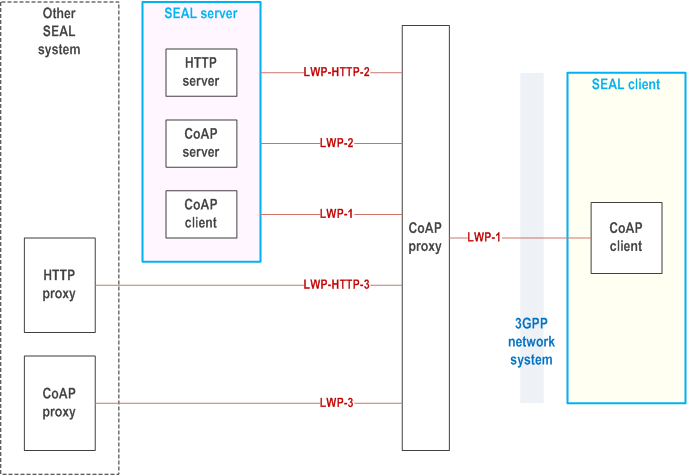Content for TS 23.434 Word version: 19.3.0
0…
4…
5
6…
6.4…
6.5…
6.5.3…
7…
8…
8.2.2…
9…
9.3…
9.3.2.21…
9.3.3…
9.3.6…
9.3.11…
9.3.13…
9.3.14…
9.4…
9.4.6…
9.5…
10…
10.3…
10.3.2.22…
10.3.3…
10.3.7…
10.3.10…
10.4…
11…
11.3…
11.3.3…
11.4…
12…
12.3…
13…
14…
14.2.2.2…
14.3…
14.3.2.20…
14.3.2.40…
14.3.3…
14.3.3.3…
14.3.4…
14.3.4.6
14.3.4.7…
14.3.4A…
14.3.4A.3…
14.3.4A.4…
14.3.4A.6…
14.3.4A.8…
14.3.4A.9…
14.3.4A.10…
14.3.5…
14.3.6…
14.3.9…
14.3.12…
14.4…
15…
16…
17…
18…
A
B…
B SEAL functional model mapping with Common functional architecture (CFA)
C Protocol realizations of LWP in the signalling control plane
C.1 General
C.2 Usage of CoAP as LWP
D Exemplary location profile attributes
$ Change history
B SEAL functional model mapping with Common functional architecture (CFA) p. 306
The Table B-1 shows the mapping between the SEAL functional model and the Common functional architecture (CFA). The details of CFA functional entities and reference points are specified in TS 23.280.
| SEAL service | Aspects | SEAL | CFA |
|---|---|---|---|
| Location management | Functional entity | Location management client | Location management client |
| Location management server | Location management server | ||
| Reference points | LM-UU | CSC-14 | |
| LM-S | CSC-15 | ||
| LM-C | Not defined | ||
| LM-E | Not defined | ||
| LM-PC5 | Not defined | ||
| Group management | Functional entity | Group management client | Group management client |
| Group management server | Group management server | ||
| Reference points | GM-UU | CSC-2 | |
| GM-S | CSC-3 | ||
| GM-C | Not defined | ||
| GM-E | CSC-16 | ||
| GM-PC5 | CSC-12 | ||
| Configuration management | Functional entity | Configuration management client | Configuration management client |
| Configuration management server | Configuration management server | ||
| Reference points | CM-UU | CSC-4 | |
| CM-S | CSC-5 | ||
| CM-C | Not defined | ||
| CM-E | CSC-17 | ||
| CM-PC5 | CSC-11 | ||
| Identity management | Functional entity | Identity management client | Identity management client |
| Identity management server | Identity management server | ||
| Reference points | IM-UU | CSC-1 | |
| IM-S | Not defined | ||
| IM-C | Not defined | ||
| IM-E | Not defined | ||
| IM-PC5 | Not defined | ||
| Key management | Functional entity | Key management client | Key management client |
| Key management server | Key management server | ||
| Reference points | KM-UU | CSC-8 | |
| KM-S | CSC-9 | ||
| KM-PC5 | Not defined | ||
| Network resource management | Functional entity | Network resource management client | Not defined (see NOTE) |
| Network resource management server | Not defined (see NOTE) | ||
| Reference points | NRM-UU | Not defined (see NOTE) | |
| NRM-S | Not defined | ||
| NRM-C | Not defined | ||
| NRM-E | Not defined | ||
| NRM-PC5 | Not defined | ||
|
NOTE:
Defined in the application layer for Mission Critical service (e.g. MCPTT).
|
|||
C (Normative) Protocol realizations of LWP in the signalling control plane |R17| p. 307
C.1 General p. 307
This Annex specifies protocol realizations of the light-weight protocol in the signalling control plane.
C.2 Usage of CoAP as LWP p. 307
This clause specifies how the CoAP protocol shall be used to realize the generic light-weight protocol in the signalling control plane.
The Constrained Application Protocol (CoAP) is a light-weight protocol defined by IETF in RFC 7252 and designed specifically for application layer communication for constrained devices. CoAP provides a request/response interaction model between application endpoints, supports built-in discovery of services and resources, and includes key concepts of the Web such as URIs and Internet media types. CoAP is designed to easily interface with HTTP for integration with the Web while meeting specialized requirements such as multicast support, very low overhead, and simplicity for constrained environments. RFC 7252 specifies bindings to UDP and DTLS. RFC 8323 specifies bindings to TCP, WebSocket and TLS.
Figure C.2-1 illustrates the functional model for the LWP signalling control plane when CoAP is used as the LWP.

When CoAP is used to realize the generic light-weight protocol defined in clause 6.2, then,
- CoAP client is a realization of the LWP client
-
CoAP proxy is a realization of the LWP proxy, with the following clarifications:
- CoAP proxy shall be able to terminate a DTLS, TLS or secure WebSocket session on LWP-1 reference point;
- CoAP proxy shall be able to act as a cross-protocol CoAP-HTTP proxy to support LWP-HTTP-2 and LWP-HTTP-3 reference points;
- CoAP server is a realization of the LWP server
- CoAP supports the interactions over LWP-1, LWP-2 and LWP-3 reference points
- The usage of CoAP by the SEAL service enablers shall follow the rules set out in clause 6.4.3.5.
D Exemplary location profile attributes |R18| p. 308
The Table D-1 shows the example of attributes that can be used for the location profiles.
| Profile ID / name | Vertical / use case/environment | Positioning Service Level (for IIOT) / QoS / accuracy | Positioning Method(s) / Priorities | Involved 3GPP functionalities / Priorities | Required APIs / API info | Other |
|---|---|---|---|---|---|---|
| Location profile #1 | Industrial scenario; indoors; mobile robots/ AGVs | Service Level 6 / cm level accuracy / absolute/relative/ both | 1. DL-TDOA,
2. UL-TDOA, 3. Multi-RTT methods, 4. WLAN, 5. motion sensors, 6. Bluetooth | 1. LMF
2. RAN-LMC, 3. SEAL LMS | NEF APIs, SEAL APIs | Verification / augmentation required |
| Location profile #2 | V2X; outdoor | Decimeter level accuracy /... absolute/relative/both | 1. DL-TDOA,
2. Multi-RTT methods, 3. GNSS-RTK, 4. Sensor fusion, 5. A-GPS | 1. LMF
2. SEAL LMS 3. Other UEs | NEF APIs, MEC APIs | Support for sidelink positioning |